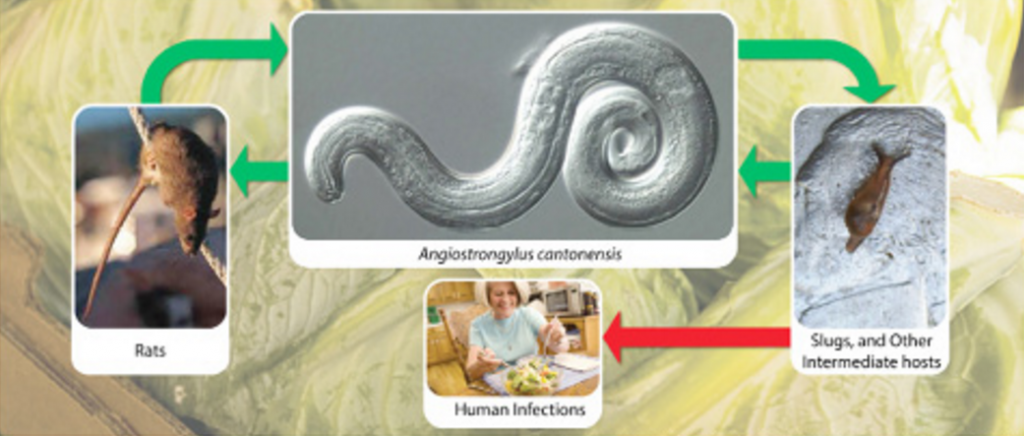Rat Lungworm Meeting in Hāna Draws Standing Room Only Crowd

Hāna community meeting on rat lungworm disease. PC: Dawn Lono
A meeting in the remote East Maui community of Hāna to discuss the threat of rat lungworm disease, drew a standing room only crowd to Helene Hall on Thursday evening.
State Health officials tell Maui Now that there are two confirmed Maui resident cases of rat lungworm and two non-resident cases with a history of travel to Maui. “In addition, four reported possible cases are under investigation and not confirmed,” according to DOH spokesperson Janice Okubo.

PC: Hawaiʻi Department of Health and Centers for Disease Control and Prevention via Office of Sen. J Kalani English. Center photo courtesy Henry S. Bishop, courtesy of Alexandre J DaSilva (CDC). Snail photo (left) PC: Chris Jacobson (CDC).
Rat lungworm is caused by a round worm parasite. The adult parasite is found in rats, but the infected rats can pass the larvae in their droppings, infecting snails and slugs that eat the larvae. Humans can become infected by eating raw produce with tiny snails or slugs that have eaten the lungworms.
According to an update from Senator J Kalani English, whose district includes East Maui, humans might also get the disease from eating under cooked freshwater prawns or frogs that have become infected from water that has come into contact with infected slugs and snails.
A DNA or blood test is conducted to detect the disease. Health workers also consider a patient’s exposure history by finding out if they have traveled to infected areas, if they have eaten raw or under cooked snails or slugs, and their consumption and preparation of raw fruits and vegetables.
While there is no specific treatment for the disease, the State Department of Health notes that the parasites cannot age or reproduce in humans and will eventually die over time, resulting in a “self-limiting” infection.
Until March, most of the cases in Hawaiʻi were reported on Hawaiʻi Island. The legislature finds that the department of health has reported over 70 cases of rat lungworm disease caused by Angiostrongylus cantonensis from 2001 to 2014.
According to Sen. English, Tricia Mynar, a preschool teacher for Kamehameha Schools on Maui, was diagnosed with the disease after feeling her first symptoms on Feb. 24, 2017. She was temporarily assigned to Hawaiʻi Island, where cases have surfaced in recent years. Initially, she reported flu-like symptoms,and then severe back pain.
According to a Sen. English’s newsletter, “The results in other patients exposed on Maui (Hāna) confirm that rat lungworm disease is here. Therefore, our communities need to take immediate action through prevention and control of the disease.”
Take Action Now: Senator English offered the following actions that can be taken by area residents now:
- The community must control the rodent population by using appropriate traps;
- DO NOT eat raw or under cooked snails or slugs, which may be in vegetables or on fruits.
- Use gloves to thoroughly wash and inspect fresh produce and vegetables, especially if eaten raw;
- Eliminate snails and slugs near houses and in the garden. Do not handle slugs/snails. Use tongs or chopsticks to dispose.
- Dispose of snails and slugs by burying them deep in the ground to avoid rodent, animal or human contact.
- Finally, he said, if you have suspicious symptoms, see your physician.
*Additional information below provided by Sen. English/Hawaiʻi DOH/ and CDC.
Symptoms: Rat lungworm can cause a disease affecting the brain and spinal cord. Symptoms may include severe headache, stiffness of the neck and back, skin tingling, pain and sensitivity to light, hallucinations, nausea, vomiting, and sometimes coma and death. They symptoms can also vary from person to person.
Treatment: There is no specific treatment for the disease; However, the parasites cannot age or reproduce in humans and will eventually die. Treatment and pain medication can be given to relieve the symptoms.
Detection: The State laboratories division can detect rat lungworm disease through a DNA or blood test. More commonly, diagnosis is based on a patients’ exposure history, such as travel to infected areas or ingesting raw or under cooked snails or slugs.
*Resources: Centers for Disease Control and Prevention; Hawaiʻi Department of Health; and Sen. J Kalani English.










